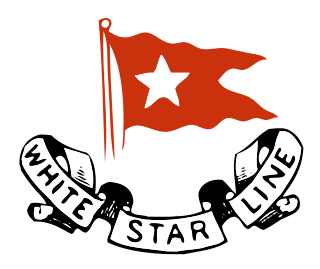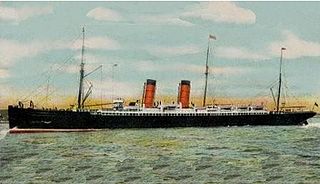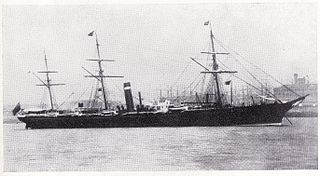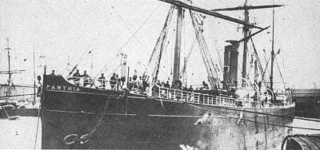
The Cunard Line is a British shipping and cruise line based at Carnival House at Southampton, England, operated by Carnival UK and owned by Carnival Corporation & plc. Since 2011, Cunard and its four ships have been registered in Hamilton, Bermuda.

The Blue Riband is an unofficial accolade given to the passenger liner crossing the Atlantic Ocean in regular service with the record highest average speed. The term was borrowed from horse racing and was not widely used until after 1910. The record is based on average speed rather than passage time because ships follow different routes. Also, eastbound and westbound speed records are reckoned separately, as the more difficult westbound record voyage, against the Gulf Stream and the prevailing weather systems, typically results in lower average speeds.

An ocean liner is a type of passenger ship primarily used for transportation across seas or oceans. Ocean liners may also carry cargo or mail, and may sometimes be used for other purposes. The Queen Mary 2 is the only ocean liner still in service to this day.

The White Star Line was a British shipping line. Founded out of the remains of a defunct packet company, it gradually rose up to become one of the most prominent shipping companies in the world, providing passenger and cargo services between the British Empire and the United States. While many other shipping lines focused primarily on speed, White Star branded their services by focusing more on providing comfortable passages for both upper class travellers and immigrants.

CP Ships was a large Canadian shipping company established in the 19th century. From the late 1880s until after World War II, the company was Canada's largest operator of Atlantic and Pacific steamships. Many immigrants travelled on CP ships from Europe to Canada. In 1914 the sinking of the Canadian Pacific steamship RMS Empress of Ireland just before World War I became largest maritime disaster in Canadian history. The company provided Canadian Merchant Navy vessels in World Wars I and II. Twelve vessels were lost due to enemy action in World War II, including the RMS Empress of Britain, which was the largest ship ever sunk by a German U-boat.

The Inman Line was one of the three largest 19th-century British passenger shipping companies on the North Atlantic, along with the White Star Line and Cunard Line. Founded in 1850, it was absorbed in 1893 into American Line. The firm's formal name for much of its history was the Liverpool, Philadelphia and New York Steamship Company, but it was also variously known as the Liverpool and Philadelphia Steamship Company, as Inman Steamship Company, Limited, and, in the last few years before absorption, as the Inman and International Steamship Company.

RMS Etruria was a transatlantic ocean liner built by John Elder & Co of Glasgow, Scotland in 1884 for Cunard Line. Etruria and her sister ship Umbria were the last two Cunarders that were fitted with auxiliary sails. Both ships were among the fastest and largest liners then in service. Etruria was completed in March 1885, twelve weeks after Umbria, and entered service on the Liverpool – New York route.
The Collins Line was the common name for the American shipping company started by Israel Collins and then built up by his son Edward Knight Collins, formally called the New York and Liverpool United States Mail Steamship Company. Under Edward Collins' guidance, the company grew to be a serious competitor on the transatlantic routes to the British Cunard shipping company.

SS Servia, also known as RMS Servia, was a successful transatlantic passenger and mail steamer of revolutionary design, built by J & G Thomson of Clydebank and launched in 1881. She was the first large ocean liner to be built of steel instead of iron, and the first Cunard ship to have an electric lighting installation.

Arizona was a record breaking British passenger liner that was the first of the Guion Line's Atlantic Greyhounds on the Liverpool-Queenstown-New York route. One nautical historian called Arizona "a souped up transatlantic hot rod." Entering service in 1879, she was the prototype for Atlantic express liners until the Inman Line introduced its twin screw City of New York in 1889. The Arizona type liner is generally considered as unsuccessful because too much was sacrificed for speed. Laid up in 1894 when Guion stopped sailings, Arizona was sold four years later and briefly employed in the Pacific until she was acquired by the US Government for service in the Spanish–American War. As the US Navy's Hancock she continued trooping through World War I, and was scrapped in 1926.

RMS Empress of India was an ocean liner built in 1890-1891 by Naval Construction & Armaments Co, Barrow-in-Furness, England for Canadian Pacific Steamships. This ship would be the first of two CP vessels to be named Empress of India, and on 28 April 1891, she was the first of many ships named Empress arriving at Vancouver harbor.

RMS Carinthia was an ocean liner built in 1956 as one of the four Saxonia class ships. She sailed for Cunard Line from her completion until 1968 when she was sold to Sitmar Line, rebuilt into a full-time cruise ship and renamed SS Fairsea. She sailed with Sitmar until 1988, when Sitmar was sold to P&O. She was renamed SS Fair Princess and sailed for Princess Cruises and P&O Cruises until 2000. She was then sold to China Sea Cruises and renamed SS China Sea Discovery. In 2005 or 2006 she was scrapped in Alang, India.

City of Paris was a British passenger liner operated by the Inman Line that established that a ship driven by a screw could match the speed of the paddlers on the Atlantic crossing. Built by Tod and Macgregor, she served the Inman Line until 1884 when she was converted to a cargo ship.
The Liverpool and Great Western Steamship Company, known commonly as the Guion Line, was a British passenger service that operated the Liverpool-Queenstown-New York route from 1866 to 1894. While incorporated in Great Britain, 52% of the company's capital was from the American firm, Williams and Guion of New York. Known primarily for transporting immigrants, in 1879 the line started commissioning Blue Riband record breakers to compete against Cunard, White Star and Inman for first class passengers. The financial troubles of one of the company's major partners in 1884 forced the firm to return its latest record breaker, the Oregon, to her builders and focus again on the immigrant trade. The company suspended sailings in 1894 because of new American restrictions on immigrant traffic.

SS Oregon was a record-breaking British passenger liner that won the Blue Riband for the Guion Line as the fastest liner on the Atlantic in 1884. She was sold to the Cunard Line after a few voyages and continued to improve her passage times for her new owner. In 1885, Oregon was chartered to the Royal Navy as an auxiliary cruiser, and her success in this role resulted in the Admiralty subsidizing suitable ships for quick conversion in the event of a crisis. She returned to Cunard service in November 1885 and four months later collided with a schooner while approaching New York. Virtually all persons on board were rescued before Oregon sank. Her wreck, 18 miles south of Long Island, remains a popular diving site.

The Rivers class was a class of eleven ocean liners of the Norddeutscher Lloyd (NDL), the first class of German express liners. The ships were built between 1881 and 1890, the first nine in Glasgow by John Elder & Co. or the renamed Fairfield Shipbuilding and Engineering Company, the last two in Stettin by Vulcan. All were named for rivers in Germany.

SS Parthia (1870–1956) was an iron-hulled transatlantic ocean liner built for the Cunard Line by William Denny and Brothers in Dumbarton, Scotland. Her sister ships were the Abyssinia and Algeria. Unlike her two sisters, Parthia was smaller, built in a different shipyard and had a slightly different funnel arrangement. The Parthia was retired by Cunard in 1883 and sold to John Elder & Co., who subsequently transferred her to the Guion Line. After serving with the Guion Line and operating on trans-Pacific routes with the Canadian Pacific Railway Company, she was refitted and renamed Victoria.

RMS Parthia was the second of two all first class transatlantic passenger cargo liners built for the Cunard Line. She later served on the London to Auckland route for the New Zealand Shipping Company under the name Remuera, and still later as a Pacific cruise ship under the name Aramac. She was scrapped in 1969–70.

The Oceanic class were a group of six ocean liners built by Harland and Wolff at Belfast, for the White Star Line, for the transatlantic service. They were the company's first generation of steamships to serve the North Atlantic passenger trade, entering service between 1871 and 1872.

The SS American was a steamship built by Harland and Wolff in Belfast, which entered service in 1895. the American was a combined cargo and passenger ship which was originally built for the West India and Pacific Steamship Company along with her sister ship the SS European. In 1904 she passed to the White Star Line and was renamed Cufic, the name she retained until she was sold to Italian ownership in 1924, after which she became known as Antartico then Maria Guilia until being scrapped in 1932.



















